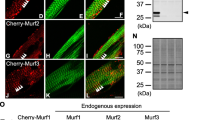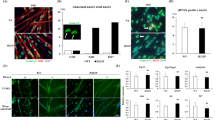Abstract
In this study we investigated the effect of recombinant activin A on the differentiation of limb muscle precursors of chick embryos. We show that treatment with activin resulted in a downregulation of Pax-3 and MyoD expression within 6 h after treatment, whereas expression of Myf-5 and Pax-7 was largely unaffected. The effect on gene expression was transient because 1 day after activin exposure the development of the premuscle masses had proceeded, and Pax-3 and MyoD expression was reexpressed at normal levels. Unlike other transforming growth factors-β, activin did not induce programmed cell death in limb mesenchyme, thus myogenic cells were not permanently lost. In high-density cultures of embryonic chick limb mesenchyme (micromass cultures), activin repressed the generation of Pax-7-expressing muscle precursors. Furthermore, in the presence of activin, fewer muscle precursors differentiated, and the population of differentiating cells failed to fuse and form myotubes. Our data suggest that activin reversibly inhibited expression of two transcription factors, Pax-3 and MyoD, and thus transiently inhibited proliferation and differentiation of limb muscle precursors. However, myogenic cells were not lost as they continued to express Pax-7 and Myf-5, and this may have allowed precursors to commence development after the activin effect faded. We suggest that activin acts in conjunction with a closely related signalling molecule, myostatin, to prevent excessive growth of skeletal muscle.



Similar content being viewed by others
References
Amthor H, Christ B, Rashid-Doubell F, Kemp CF, Lang E, Patel K (2002a) Follistatin regulates bone morphogenetic protein-7 (BMP-7) activity to stimulate embryonic muscle growth. Dev Biol 243:115–127
Amthor H, Huang R, McKinnell I, Christ B, Kambadur R, Sharma M, Patel K (2002b) The regulation and action of myostatin as a negative regulator of muscle development during avian embryogenesis. Dev Biol 251:241–257
Amthor H, Nicholas G, McKinnell I, Kemp CF, Sharma M, Kambadur R, Patel K (2004) Follistatin complexes myostatin and antagonises myostatin-mediated inhibition of myogenesis. Dev Biol 270:19–30
Amthor H, Macharia R, Otto A, Patel K (2005) Stop and go—myostatin defines quiescent muscle precursors that can be reactivated. [submitted]
Cohn MJ, Izpisua-Belmonte JC, Abud H, Heath JK, Tickle C (1995) Fibroblast growth factors induce additional limb development from the flank of chick embryos. Cell 80:739–746
Daniels K, Reiter R, Solursh M (1996) Micromass cultures of limb and other mesenchyme. Methods Cell Biol 51:237–247
Fainsod A, Deissler K, Yelin R, Marom K, Epstein M, Pillemer G, Steinbeisser H, Blum M (1997) The dorsalizing and neural inducing gene follistatin is an antagonist of BMP-4. Mech Dev 63:39–50
Gamer LW, Wolfman NM, Celeste AJ, Hattersley G, Hewick R, Rosen V (1999) A novel BMP expressed in developing mouse limb, spinal cord, and tail bud is a potent mesoderm inducer in Xenopus embryos. Dev Biol 208:222–232
Hamburger V, Hamilton HL (1992) A series of normal stages in the development of the chick embryo. 1951. Dev Dyn 195:231–272
Hemmati-Brivanlou A, Melton DA (1994) Inhibition of activin receptor signaling promotes neuralization in Xenopus. Cell 77:273–281
Iemura S, Yamamoto TS, Takagi C, Uchiyama H, Natsume T, Shimasaki S, Sugino H, Ueno N (1998) Direct binding of follistatin to a complex of bone-morphogenetic protein and its receptor inhibits ventral and epidermal cell fates in early Xenopus embryo. Proc Natl Acad Sci USA 95:9337–9342
Lee SJ (2004) Regulation of muscle mass by myostatin. Annu Rev Cell Dev Biol 20:61–86
Lee SJ, McPherron AC (2001) Regulation of myostatin activity and muscle growth. Proc Natl Acad Sci USA 98:9306–9311
Link BA, Nishi R (1997) Opposing effects of activin A and follistatin on developing skeletal muscle cells. Exp Cell Res 233:350–362
McCroskery S, Thomas M, Maxwell L, Sharma M, Kambadur R (2003) Myostatin negatively regulates satellite cell activation and self-renewal. J Cell Biol 162:1135–1147
McPherron AC, Lawler AM, Lee SJ (1997) Regulation of skeletal muscle mass in mice by a new TGF-beta superfamily member. Nature 387:83–90
McPherron AC, Lawler AM, Lee SJ (1999) Regulation of anterior/posterior patterning of the axial skeleton by growth/differentiation factor 11. Nat Genet 22:260–264
Muttukrishna S, Tannetta D, Groome N, Sargent I (2004) Activin and follistatin in female reproduction. Mol Cell Endocrinol 225:45–56
Nieto MA, Patel K, Wilkinson DG (1996) In situ hybridization analysis of chick embryos in whole mount and tissue sections. Methods Cell Biol 51:219–235
Relaix F, Rocancourt D, Mansouri A, Buckingham M (2004) Divergent functions of murine Pax3 and Pax7 in limb muscle development. Genes Dev 18:1088–1105
Seale P, Sabourin LA, Girgis-Gabardo A, Mansouri A, Gruss P, Rudnicki MA (2000) Pax7 is required for the specification of myogenic satellite cells. Cell 102:777–786
Swalla BJ, Solursh M (1986) The independence of myogenesis and chondrogenesis in micromass cultures of chick wing buds. Dev Biol 116:31–38
Tuuri T, Eramaa M, Hilden K, Ritvos O (1994) The tissue distribution of activin beta A- and beta B-subunit and follistatin messenger ribonucleic acids suggests multiple sites of action for the activin-follistatin system during human development. J Clin Endocrinol Metab 78:1521–1524
Zammi PS, Heslop L, Hudon V, Rosenblatt JD, Tajbakhsh S, Buckingham ME, Beauchamp JR, Partridge TA (2002) Kinetics of myoblast proliferation show that resident satellite cells are competent to fully regenerate skeletal muscle fibers. Exp Cell Res 281:39–49
Acknowledgments
This work was supported by grants from the Deutsche Forschungsgemeinschaft to H.A. (Am 151/2-1), R.H. (Hu 729/2-2), and B.C. (SFB 592 A1); from The Wellcome Trust (066195) to K.P. and R.M.; and from EMBO (ASTF 93-2004) to K.V. We would like to thank Elaine Shervill for technical assistance.
Author information
Authors and Affiliations
Corresponding author
Rights and permissions
About this article
Cite this article
He, L., Vichev, K., Macharia, R. et al. Activin A inhibits formation of skeletal muscle during chick development. Anat Embryol 209, 401–407 (2005). https://doi.org/10.1007/s00429-005-0454-1
Accepted:
Published:
Issue Date:
DOI: https://doi.org/10.1007/s00429-005-0454-1




